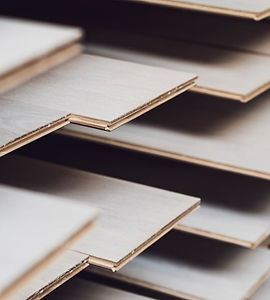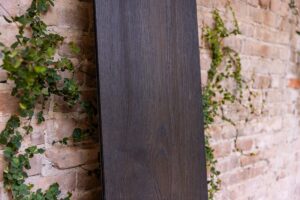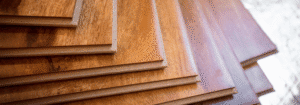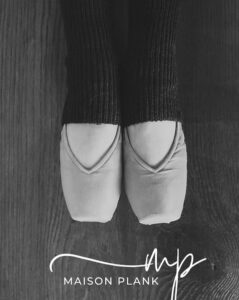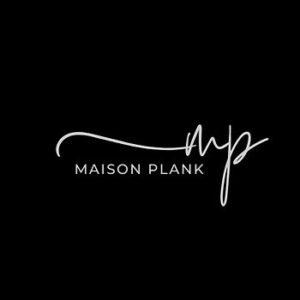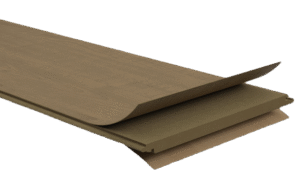Last Reviewed: October 21, 2025
With so many options on the market, the process of finding the best possible flooring material for the job at hand while staying on budget can be overwhelming. In addition to finishes and construction materials, an important price variable is the plank thickness – a specification that should never be overlooked. Let us take some of the guesswork out of the selection process with our expert tips on
engineered hardwood flooring thickness.
Understanding the Construction
The Wear Layer
High-quality engineered hardwood flooring is constructed in a cross-ply, two or three-layered design. The top layer, or
wear layer, is a hardwood veneer ranging in thickness from 1.5mm to 8mm, depending on the product line. The wear layer is the only visible section and its thickness directly correlates to both the floor’s longevity and refinishing capability. To allow for sanding and refinishing comparable to traditional hardwood flooring, the wear layer should be a minimum of 4 mm.
The Base Layer
Beneath the wear layer lies the core material, or base layer, composed of plywood sheets that are glued together to form an incredibly strong platform. Depending on the manufacturer, the base layer can range dramatically in both quality and thickness. To avoid future failures like delamination, cupping, or warping, choose engineered hardwood made with strong plywood material (like birch) with 9 to 11-layer construction. Some product lines offer a third layer of backing material to equalize moisture levels from the subfloor.
Factors to Consider: Selecting the Right Thickness for the Project
Previous Floor Thickness
When installing engineered hardwood over an existing floor, a thinner wear layer should be used to avoid raising the finished height. When replacing an existing floor, changing the thickness of the material may snowball into replacing moldings, baseboards, and thresholds, as well as adjusting door heights and transitions to other flooring products.
Subfloor Type
Concrete and other non-level subfloors may require thicker material for added structural stability.
Installation Method
Nail-down installations may require thicker flooring than those that use the floating method.
Product Use
Commercial spaces or residential areas that receive high foot traffic or are prone to water exposure can benefit from thicker wear layers.
Heated Flooring
Radiant heat systems require engineered hardwood with minimal thickness to avoid insulation disruptions.
Appearance
Keeping the overall height of the floor in mind, some customers may opt for a thicker wear layer for additional character or visual appeal.
Budget
Careful selection of a thickness suited to the job at hand can balance performance and cost.
Haute Plank’s Collections by Thickness
The Belgium Collection Total Thickness: 5/8″ to 3/4″ (15.88mm to 19mm) depending on line within the collection and custom options chosen.
Wear Layer
Thickness: 4mm to 6mm
Material: Oak, Exotic Woods available on request
Base Layer
Thickness: 12mm – 14mm
Material: Various Hardwoods including Pine, Poplar, and Birch Plywood
The Spain CollectionTotal Thickness: 5/8″ (15.88mm)
Wear Layer
Thickness: 4mm
Material: Oak
Base Layer
Thickness: 12mm
Material: Birch Phenolic Plywood
The Netherlands CollectionTotal Thickness: 13mm, 16mm, or 20mm (1/2″ to 3/4″+)
Wear Layer
Thickness: 4mm Material: Oak
Base Layer
Thickness: 9mm to 16mm
Material: WBP Exterior Birch Plywood
3/4″ Grand Collection Total Thickness: 3/4″ (19mm) with thicker custom options available.
Wear Layer
Thickness: 4 mm
Material: Oak
Base Layer
Thickness: 15 mm
Material: Waterproof Birch Plywood
Maison Plank: Luxury Hardwood Without Thickness Limits
Traditional engineered hardwood often relies on plywood cores, which can be prone to expansion, warping, and height restrictions. Maison Plank offers a smarter alternative. With a high-density fiberboard (HDF) core, it delivers exceptional stability, water resistance, and strength in a thinner profile without compromising on luxury.
Resists warping and shrinkage better than plywood
Withstands water exposure for up to 24 hours ideal for kitchens, baths, and high-traffic areas
Real European oak surface for an authentic hardwood look and feel
Looking for a versatile, high-performance engineered hardwood? Explore the
Maison Plank Collection today.
Or for more information about our
luxury engineered hardwood, visit our website at
www.www.hauteplank.com or download our specification sheet on each collection page.
